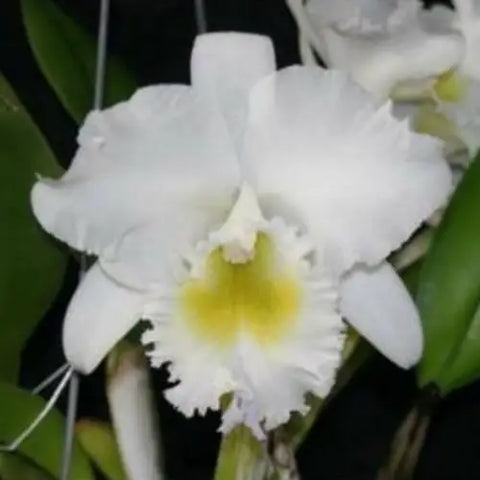
B. David Sander (B. cucullata x Rl. digbyana) – 3" Pot
B. David Sander
(B. cucullata x Rl. digbyana) – 3" Pot
Fragrant, Historic Brassavola Hybrid with Starry Summer Blooms
Brassavola David Sander is a historic, sweetly fragrant orchid hybrid created by crossing Brassavola cucullata with Rhyncholaelia digbyana. First registered in 1938 by Sanders of St Albans, this primary hybrid is known for its large, star-shaped creamy white blooms and intoxicating nighttime fragrance. This plant is a collector favorite for its size, scent, and strong summer flowering habit.
Flowers can span over 6 inches across when fully open, with ruffled lips and soft blush tones that fade as they mature. The fragrance—citrusy and sweet—is most intense in the evening. Grown epiphytically, the plant has slender, pencil-like pseudobulbs and narrow leaves, giving it a graceful, upright form.
This listing is for a blooming-size plant in a 3" pot. Availability is limited due to slow propagation and collector demand.
Why Growers Love B. David Sander
Growers love Brassavola David Sander for its combination of stunning form, powerful fragrance, and historic pedigree. The hybrid brings together the frilly lip of R. digbyana with the elegant star shape and growth style of B. cucullata. Its blooms are impressive in both size and quantity, with up to three flowers per spike. The citrusy fragrance is strongest at night and fills a room—an unforgettable trait that sets it apart from most orchids. Its summer bloom cycle adds variety to a collection typically dominated by spring and winter bloomers.
This orchid also appeals to collectors of classic and historical crosses. With registration dating back to 1938, owning this hybrid is like growing a living piece of orchid history.
Plant Details:
-
Full Name: Brassavola David Sander (B. cucullata × Rhyncholaelia digbyana)
-
Pot Size: 3"
-
Growth Stage: Blooming Size
-
Bloom Size: Up to 6" wide
-
Blooming Season: Primarily Summer; may bloom off-season with favorable conditions
-
Fragrance: Yes – strong, sweet citrus scent, most noticeable at night
-
Growth Habit: Epiphytic with slender pseudobulbs and narrow leaves
Cattleya Culture
Light:
Light is the most important factor for growing and blooming cattleyas. They love bright light—but not harsh, direct sun in the middle of the day. In your home, an east-facing window is ideal, or a shaded south or west window (use a sheer curtain if needed). In a greenhouse, aim for 50–70% full sun (about 3,000 to 5,000 foot-candles). A healthy Cattleya should have medium green leaves and stand upright without needing a stake.
Temperature:
Cattleyas like it warm during the day—about 70–85°F—and cooler at night—around 55–60°F. Seedlings do best with slightly warmer nights. A day/night difference of 15–20 degrees helps trigger blooming. They can handle up to 95°F if humidity and airflow are increased.
Watering & Humidity:
Watering depends on your pot size, media, temperature, and light levels. Mature plants need to dry out completely before the next watering. Seedlings prefer a bit more moisture. You can tell when it’s time to water by lifting the pot—light means dry, heavy means wet. When in doubt, wait a day. Never use water below 50°F, and avoid softened water with added salts.
Cattleyas enjoy humidity between 50–80%. At home, use a humidity tray with pebbles and make sure your pot doesn’t sit in the water. Airflow is key—moving air helps prevent disease. In greenhouses, use humidifiers or evaporative coolers to maintain proper moisture in the air.
Fertilizing:
Feed your cattleyas regularly. If you're growing in fir bark, use a high-nitrogen formula like 30-10-10. Otherwise, use a balanced fertilizer. During active growth, fertilize every two weeks. When growth slows, switch to once a month. You can also feed lightly (at ¼ strength) every time you water. Once a month, flush with plain water to wash out any salt buildup.
Repotting:
Repot every 2–3 years or when you see roots creeping over the edge or the potting mix breaks down. The best time to repot is right after blooming or in spring—just before new roots start to grow. Use coarser mix for mature plants, finer mix for young ones. Only divide a plant if it has at least 6 pseudobulbs. Each division should have 3–5 healthy bulbs. Pick a pot that allows for two years of new growth.
To repot:
-
Place fresh mix against one side of the new pot.
-
Trim any dead roots.
-
Lay the healthy roots on the mix with the cut rhizome against the pot wall.
-
Fill in and firm the mix around the roots.
-
Stake if needed.
-
Keep humid and shaded until you see new root growth.
We Also Recommend





